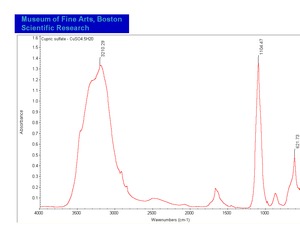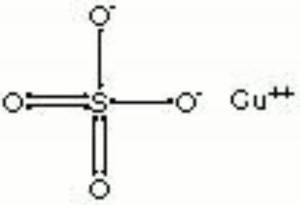Difference between revisions of "Copper sulfate"
| (One intermediate revision by the same user not shown) | |||
| Line 2: | Line 2: | ||
Blue granules or triclinic crystals. Copper sulfate occurs in nature as the minerals [[chalcanthite]] (hydrated) and hydrocyanite (anhydrous). It is made synthetically by the reaction of [[sulfuric acid]] with [[copper]] or [[copper oxide red|copper oxide]]. Copper sulfate (chalcanthite) is also found as a corrosion product on outdoor copper and copper alloys in areas with sulfur dioxide pollution. Copper sulfate was a major source of copper or in early civilizations. It has also been used as a mordant and as a bluish green dye. Copper sulfate is used as a biocide and as a preservative for [[wood]], [[paper]] and [[leather]]. It is also used in indelible inks, in metal coloring baths and as a copper print toner in photography. Anhydrous copper sulfate quickly absorbs water, turning blue. As a chemical reagent, blue copper sulfate reacts with reducing sugars to form red copper oxide. | Blue granules or triclinic crystals. Copper sulfate occurs in nature as the minerals [[chalcanthite]] (hydrated) and hydrocyanite (anhydrous). It is made synthetically by the reaction of [[sulfuric acid]] with [[copper]] or [[copper oxide red|copper oxide]]. Copper sulfate (chalcanthite) is also found as a corrosion product on outdoor copper and copper alloys in areas with sulfur dioxide pollution. Copper sulfate was a major source of copper or in early civilizations. It has also been used as a mordant and as a bluish green dye. Copper sulfate is used as a biocide and as a preservative for [[wood]], [[paper]] and [[leather]]. It is also used in indelible inks, in metal coloring baths and as a copper print toner in photography. Anhydrous copper sulfate quickly absorbs water, turning blue. As a chemical reagent, blue copper sulfate reacts with reducing sugars to form red copper oxide. | ||
| − | + | [[[SliderGallery rightalign|Cupric sulfate.TIF~FTIR (MFA)|copper sulfate.jpg~Chemical structure]]] | |
See also [[Copper sulfate, dibasic|dibasic copper sulfate]] ([[antlerite]]) and [[copper sulfate, tribasic|tribasic copper sulfate]] ([[brochantite]]) | See also [[Copper sulfate, dibasic|dibasic copper sulfate]] ([[antlerite]]) and [[copper sulfate, tribasic|tribasic copper sulfate]] ([[brochantite]]) | ||
| Line 8: | Line 8: | ||
copper sulfate pentahydrate; copper sulphate (Br.); cupric sulfate; blue vitriol; bluestone; blue copperas; vitriol of Venus; Roman vitriol; Salzburg vitriol; Kupfersulfat (Deut.); Kupfervitriol (Deut.); sulfate de cuivre (Fr.); kopersulfaat (Ned.); siarczan miedzi (Pol.); sulfato de cobre (Port.) | copper sulfate pentahydrate; copper sulphate (Br.); cupric sulfate; blue vitriol; bluestone; blue copperas; vitriol of Venus; Roman vitriol; Salzburg vitriol; Kupfersulfat (Deut.); Kupfervitriol (Deut.); sulfate de cuivre (Fr.); kopersulfaat (Ned.); siarczan miedzi (Pol.); sulfato de cobre (Port.) | ||
| − | |||
| − | |||
== Risks == | == Risks == | ||
| − | Toxic by ingestion. Strongly irritating to skin and membranes. | + | * Toxic by ingestion. |
| − | + | * Strongly irritating to skin and membranes. | |
| − | ThermoFisher: [https://www.fishersci.com/msds?productName=AC422870050 SDS] | + | * ThermoFisher: [https://www.fishersci.com/msds?productName=AC422870050 SDS] |
== Physical and Chemical Properties == | == Physical and Chemical Properties == | ||
| Line 29: | Line 27: | ||
|- | |- | ||
! scope="row"| Melting Point | ! scope="row"| Melting Point | ||
| − | | 150 | + | | 150 C |
|- | |- | ||
! scope="row"| Density | ! scope="row"| Density | ||
| − | | 2.284 | + | | 2.284 g/ml |
|- | |- | ||
! scope="row"| Molecular Weight | ! scope="row"| Molecular Weight | ||
| Line 41: | Line 39: | ||
|} | |} | ||
| − | == | + | == Resources and Citations == |
* Richard S. Lewis, ''Hawley's Condensed Chemical Dictionary'', Van Nostrand Reinhold, New York, 10th ed., 1993 | * Richard S. Lewis, ''Hawley's Condensed Chemical Dictionary'', Van Nostrand Reinhold, New York, 10th ed., 1993 | ||
| Line 55: | Line 53: | ||
* Susan E. Schur, Conservation Terminology: A review of Past & Current Nomenclature of Materials, ''Technology and Conservation'', Spring (p.34-39); Summer (p.35-38); Fall (p.25-36), 1985 | * Susan E. Schur, Conservation Terminology: A review of Past & Current Nomenclature of Materials, ''Technology and Conservation'', Spring (p.34-39); Summer (p.35-38); Fall (p.25-36), 1985 | ||
| − | * Wikipedia | + | * Wikipedia: http://en.wikipedia.org/wiki/Copper_sulfate |
| − | * | + | * Conservation termlist - www.hants.org.uk/museums |
| − | * | + | * Photographic chemicals - www.jetcity.com/~mrjones/chemdesc.htm |
* ''CRC Handbook of Chemistry and Physics'', Robert Weast (ed.), CRC Press, Boca Raton, Florida, v. 61, 1980 Comment: ref. index=1.724, 1.733, 1.739 | * ''CRC Handbook of Chemistry and Physics'', Robert Weast (ed.), CRC Press, Boca Raton, Florida, v. 61, 1980 Comment: ref. index=1.724, 1.733, 1.739 | ||
Latest revision as of 14:22, 4 July 2022
Description
Blue granules or triclinic crystals. Copper sulfate occurs in nature as the minerals Chalcanthite (hydrated) and hydrocyanite (anhydrous). It is made synthetically by the reaction of Sulfuric acid with Copper or copper oxide. Copper sulfate (chalcanthite) is also found as a corrosion product on outdoor copper and copper alloys in areas with sulfur dioxide pollution. Copper sulfate was a major source of copper or in early civilizations. It has also been used as a mordant and as a bluish green dye. Copper sulfate is used as a biocide and as a preservative for Wood, Paper and Leather. It is also used in indelible inks, in metal coloring baths and as a copper print toner in photography. Anhydrous copper sulfate quickly absorbs water, turning blue. As a chemical reagent, blue copper sulfate reacts with reducing sugars to form red copper oxide.
See also dibasic copper sulfate (Antlerite) and tribasic copper sulfate (Brochantite)
Synonyms and Related Terms
copper sulfate pentahydrate; copper sulphate (Br.); cupric sulfate; blue vitriol; bluestone; blue copperas; vitriol of Venus; Roman vitriol; Salzburg vitriol; Kupfersulfat (Deut.); Kupfervitriol (Deut.); sulfate de cuivre (Fr.); kopersulfaat (Ned.); siarczan miedzi (Pol.); sulfato de cobre (Port.)
Risks
- Toxic by ingestion.
- Strongly irritating to skin and membranes.
- ThermoFisher: SDS
Physical and Chemical Properties
Soluble in water, methanol. Slightly soluble in ethanol, glycerol.
| Composition | CuSO4-5H2O |
|---|---|
| CAS | 7758-98-7 |
| Melting Point | 150 C |
| Density | 2.284 g/ml |
| Molecular Weight | mol. wt. = 159.60 |
| Refractive Index | 1.724, 1.733, 1.739 |
Resources and Citations
- Richard S. Lewis, Hawley's Condensed Chemical Dictionary, Van Nostrand Reinhold, New York, 10th ed., 1993
- The Merck Index, Martha Windholz (ed.), Merck Research Labs, Rahway NJ, 10th edition, 1983 Comment: entry #2722
- Palmy Weigle, Ancient Dyes for Modern Weavers, Watson-Guptill Publications, New York, 1974
- Michael McCann, Artist Beware, Watson-Guptill Publications, New York City, 1979
- John and Margaret Cannon, Dye Plants and Dyeing, Herbert Press, London, 1994
- Susan E. Schur, Conservation Terminology: A review of Past & Current Nomenclature of Materials, Technology and Conservation, Spring (p.34-39); Summer (p.35-38); Fall (p.25-36), 1985
- Wikipedia: http://en.wikipedia.org/wiki/Copper_sulfate
- Conservation termlist - www.hants.org.uk/museums
- Photographic chemicals - www.jetcity.com/~mrjones/chemdesc.htm
- CRC Handbook of Chemistry and Physics, Robert Weast (ed.), CRC Press, Boca Raton, Florida, v. 61, 1980 Comment: ref. index=1.724, 1.733, 1.739

